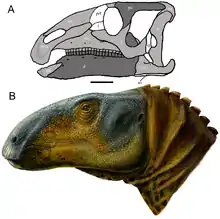Hadrosauromorpha
Hadrosauromorpha is a cohort of iguanodontian ornithopods, defined in 2014 by David B. Norman to divide Hadrosauroidea into the basal taxa with compressed manual bones and a pollex, and the derived taxa that lack them. The clade is defined as all the taxa closer to Edmontosaurus regalis than Probactrosaurus gobiensis. This results in different taxon inclusion depending on the analysis.
| Hadrosauromorphs | |
|---|---|
 | |
| Skeleton of Bactrosaurus | |
| Scientific classification | |
| Kingdom: | Animalia |
| Phylum: | Chordata |
| Clade: | Dinosauria |
| Order: | †Ornithischia |
| Suborder: | †Ornithopoda |
| Clade: | †Hadrosauriformes |
| Superfamily: | †Hadrosauroidea |
| Clade: | †Hadrosauromorpha Norman, 2015 vide Norman, 2014 |
| Subgroups[1][2][3] | |
| |
Classification
Hadrosauromorpha was first used in literature by David B. Norman in 2014 in a discussion of phylogenetics of Hypselospinus. In his 2014 paper Norman references another of his publications as the authority for Hadrosauromorpha, a chapter in the book Hadrosaurs.[1] However, the book was in fact published later, in 2015.[4] Following Article 19.4 of the PhyloCode, the authorship of the clade is thus Norman (2015), while the authorship of the definition is Norman (2014).[5]
Definition
Hadrosauromorpha was defined by Norman (2014 and 2015) as hadrosauroid taxa closer to Edmontosaurus regalis than Probactrosaurus gobiensis.[1][4] This definition was contested by Mickey Mortimer, who stated that to follow the PhyloCode the taxon Hadrosaurus must be included in the definition, as it is the type genus of Hadrosauromorpha.[6] By this definition, Norman (2015) considered Hadrosauromorpha to include Hadrosauridae, as well as the taxa Tethyshadros and Bactrosaurus.[4] Norman in 2014 had included more taxa in Hadrosauromorpha, those of Norman (2015) as well as Levnesovia, Gilmoreosaurus and Telmatosaurus, the last of which was considered inside Hadrosauridae by Norman in 2015.[1] Another phylogenetic analysis by Xing et al. in 2014 also found that Eolambia and Protohadros, both found outside Hadrosauromorpha by Norman, fell within his definition, as well as a large number of other taxa.[2]
Phylogeny
Many different versions of phylogenies have been conducted on the group of hadrosauromorphs.[2] Norman (2014) created his own analysis, which includes 105 different morphological characters and 27 select ornithopod taxa. His phylogeny is shown below, using his specific clade definitions:[1]
| Hadrosauriformes (Altirhinus + Edmontosaurus) |
| ||||||||||||||||||||||||||||||||||||||||||||||||||||||
Norman's definitions have been heavily criticized by Mickey Mortimer as being unnecessary changes which cause more confusion to classification.[6] Other phylogenetic analyses, like that of Xing et al. shown below, use traditional clade definitions (Hadrosauromorpha has been added as defined[1]) and have recovered different results.[2] Huehuecanauhtlus has also been found as one of the most derived hadrosauromorphans, between Gilmoreosaurus and Hadrosauridae.[3]

| Hadrosauroidea |
| |||||||||||||||||||||||||||||||||||||||||||||||||||||||||||||||||||||||||||||||||||||||||||||||||||
Description

Probactrosaurus was selected as the outgroup to Hadrosauromorpha because of numerous differences that Norman (2014) thought to be significant. The tooth crowns in the dentary are asymmetrical and have multiple vertical ridges; there is a foramen in the surangular; and the quadrate bone has a more prominent depression for the articulation of the jugal. None of these features are found in the skulls of the more derived hadrosauromorphans. The premaxilla contacts the prefrontal, and the jugal contact with the ectopterygoid bone of the palate is reduced.[1]
In the appendicular regions, hadrosauromorphans the scapulae are not J shaped, instead having an overhanging projection. The lower forelimb bones are more slender in both hadrosauromorphans and Probactosaurus, unlike their more robust ancestors. Probactosaurus, however, possesses the basal condition of having a small, conical pollex, like in earlier ornithopods such as Iguanodon or Hypselospinus. This absence of a pollex is also linked to a reduction of the carpal bones, and a less mobile manus. The ilium bones of Probactrosaurus are more angular than in hadrosauromorphs, which lack a brevis shelf. It was also identified that the femoral shaft is straight in hadrosauromorphans and the pedal bones are truncated[1]
References
- Norman, D.B. (2014). "On the history, osteology, and systematic position of the Wealden (Hastings group) dinosaur Hypselospinus fittoni (Iguanodontia: Styracosterna)". Zoological Journal of the Linnean Society. 2014: 1–98. doi:10.1111/zoj.12193.
- Xing, H.; Wang, D.; Han, F.; Sullivan, C.; Ma, Q.; He, Y.; Hone, D.W.E.; Yan, R.; Du, F.; Xu, X. (2014). "A New Basal Hadrosauroid Dinosaur (Dinosauria: Ornithopoda) with Transitional Features from the Late Cretaceous of Henan Province, China". PLOS ONE. 9 (6): e98821. doi:10.1371/journal.pone.0098821. PMC 4047018. PMID 24901454.
- Ramírez-Velasco, A.A.; Benammi, M.; Prieto-Márquez, A.; Ortega, J.A.; Hernández-Rivera, R. (2012). "Huehuecanauhtlus tiquichensis, a new hadrosauroid dinosaur (Ornithischia: Ornithopoda) from the Santonian (Late Cretaceous) of Michoacán, Mexico". Canadian Journal of Earth Sciences. 49 (2): 379–395. doi:10.1139/e11-062.
- Norman, D.B. (2015). "Iguanodonts from the Wealden of England: do they contribute to the discussion concerning hadrosaur origins?". In Evans, D.C.; Eberth, D.A. (eds.). Hadrosaurs. Indiana University Press. pp. 10–43. ISBN 978-0-253-01385-9.
- "Chapter VIII. Authorship of Names and Definitions. Article 19". The PhyloCode. Retrieved 1 September 2017.
- Mortimer, M. (2014). "Norman's nomenclature's notoriously negative". The Theropod Database Blog. Retrieved 1 September 2017.





.jpg.webp)
